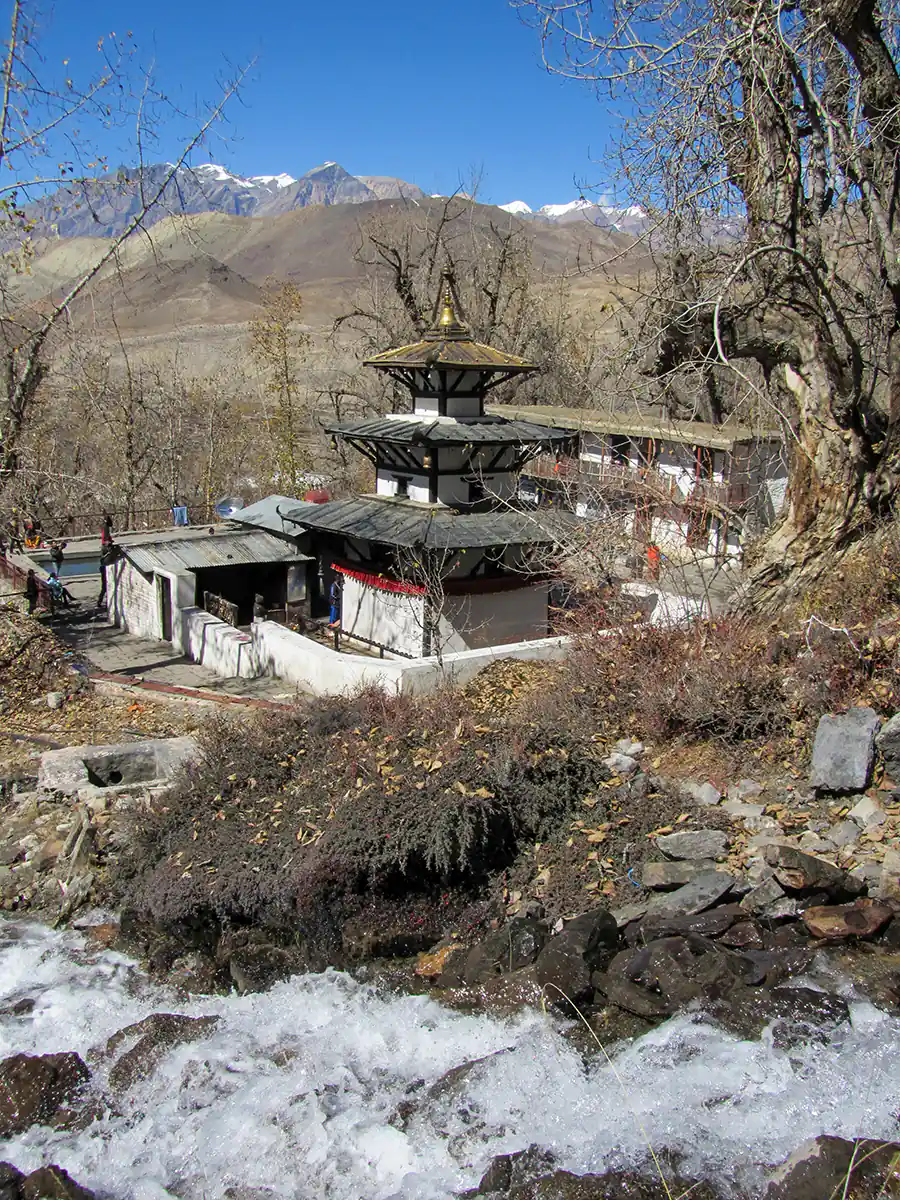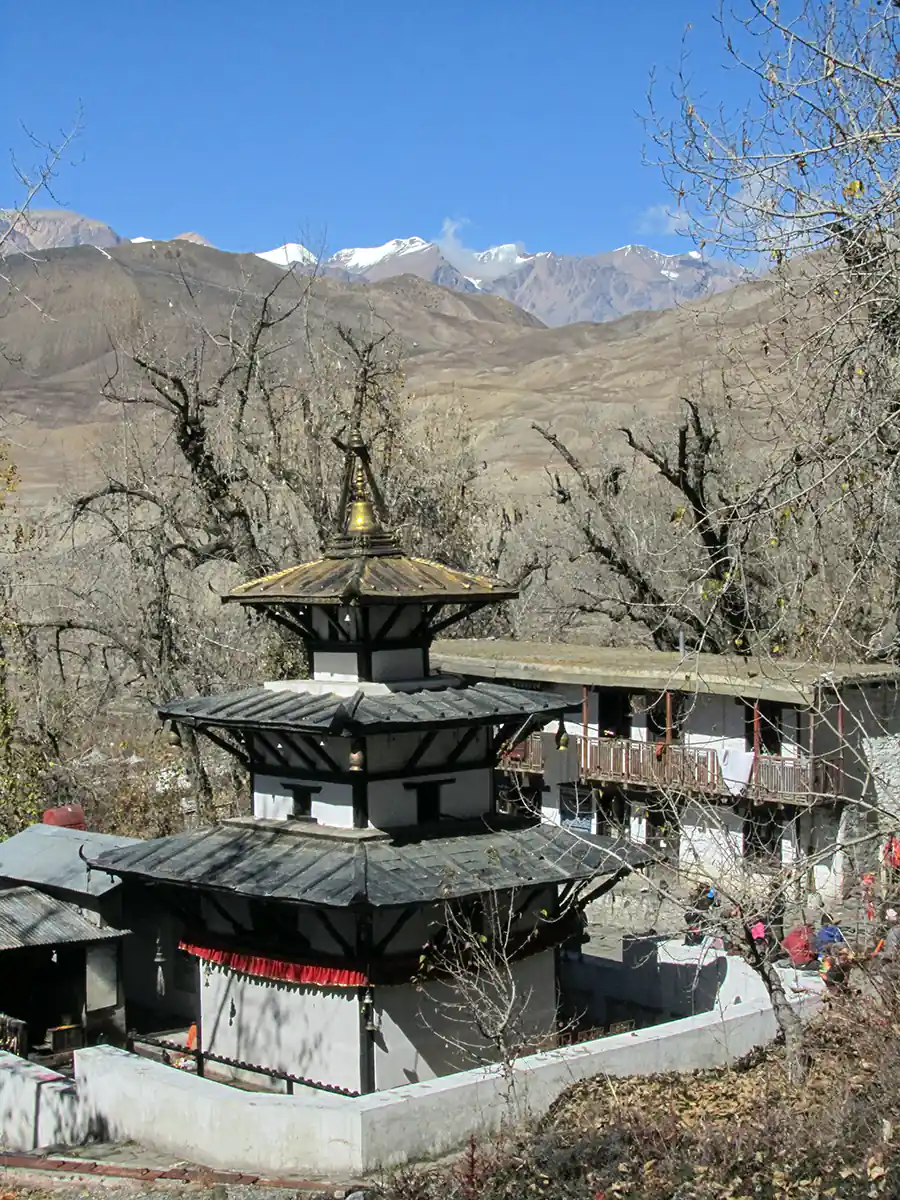Muktinath
Situated at an altitude of 3,710 meters (12,172 feet) at the base of the Thorong La mountain pass in the Mustang district, Muktinath is a highly revered sacred place for both Hindus and Buddhists.
Hindus call the site Mukti Kshetra, which means the "place of salvation," is one of the most ancient temples of the God Vishnu and the Vaishnava tradition in Nepal. The shrine is considered to be one of the eight sacred places known as Svayam Vyakta Ksetras (the other seven being Srirangam, Srimushnam, Tirupati, Naimisharanya, Totadri, Pushkar, and Badrinath), as well as one of the 108 Divya Desam, or holy places of worship of Lord Vishnu. Additionally, it is also one of the 51 Shakti Pitha goddess sites.
The small temple contains a human-sized golden statue of Vishnu as Shri Mukti Narayana. In addition to Mukti Narayana, the temple has bronze images of Bhoodevi (the Earth-goddess form of Lakshmi), the goddesses Saraswati and Janaki (Sita), Garuda (the mount of Vishnu), Lava-Kusa (the sons of Rama and Sita) and the Sapta Rishis (Seven Sages created by Lord Brahma). An old Buddhist monk is present in the temple, and Buddhist nuns conduct worship.
Behind the temple is a semi-circular wall with 108 stone faucets at a height of seven feet. The faucets all have the same shape of a bull's head and are separated by approximately one foot. Water from the ice-cold Kali Gantaki River has been diverted to flow through the mouths of these bulls, and hardy pilgrims who visit the temple often stand beneath each of the spouts.
The number 108 carries great significance in Eastern philosophy. In Hindu astrology, there are 12 zodiacs, or Rashi, and 9 planets, or Graha, giving a total of 108 combinations. Also, there are 27 Lunar mansions or Nakshatras, divided into 4 quarters, or Padas, each showing a combination of 108 Padas.
The Kali Gantaki riverbed downstream from Muktinath is the sole source of the rare Shaligram stones required to establish a temple of Vishnu anywhere in the world.
Buddhists call Muktinath Chumming Gyatsa, which in Tibetan means 'Hundred Waters.' According to Tibetan Buddhism, Chumig Gyatsa is a sacred place of the Dakinis goddesses known as Sky Dancers and is also one of the 24 celebrated Tantric places. Additionally, the site is believed to be a manifestation of Avalokitesvara, the Bodhisattva of Compassion and Virtue. The Tibetan Buddhist tradition states that Guru Rimpoche, also known as Padmasambhava, the founder of Tibetan Buddhism, meditated here on his way to Tibet.
After completing prayers and worship at the Muktinath temple, many Hindu and Buddhist pilgrims visit Mebar Lha Gomba, the small monastery of `miraculous fire,' which is situated near the temple's entrance gate. This monastery, dedicated to Guru Rimpoche (Padmasambhava) and containing a statue of the Buddhist deity Chenrezig (Avalokitesvara), is famous for its continuously burning natural gas fire, which Hindus worship as Jwala Mai, the Goddess of Fire.

Martin Gray is a cultural anthropologist, writer and photographer specializing in the study of pilgrimage traditions and sacred sites around the world. During a 40 year period he has visited more than 2000 pilgrimage places in 160 countries. The World Pilgrimage Guide at sacredsites.com is the most comprehensive source of information on this subject.




